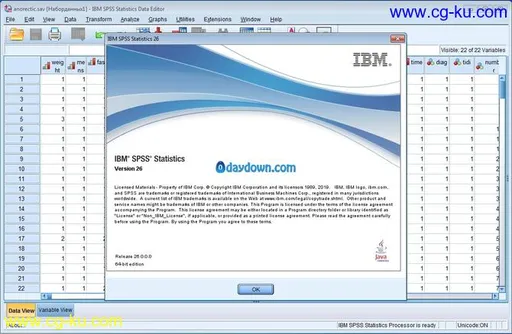专业的数据统计分析软件,它的主要功能就是数据录入、资料编辑、数据管理、统计分析、报表制作、图形绘制等等,并且软件本身以及功能方面也还在不断完善、更新。同时使用操作也是非常简单,非常容易上手
IBM SPSS Statistics 26.0 IF006 | 5.6 Gb
Languages: English, Português, Français, Deutsch, Italiano, 日本語, 한국어, Polski,
Русский, Español, Simplified 中文, Thaditional 中文.
In April of this year, IBM released the latest version of SPSS Statistics. Version 26 introduces a number of additional analysis procedures as well as new command enhancements.
What’s new in IBM SPSS Statistics v26
This page presents a brief overview of key new features in SPSS v26. These features bring much desired new statistical tests, enhancements to existing statistics and scripting procedures, and new production facility capabilities to the Classic user interface, which all originated from customer feedback. Here is what you can do with the new features in version 26:
New analytical procedures
Quantile Regression
In standard ‘least squares’ regression the model predictions are based on a single regression line. This line can be used to estimate the mean value of the dependent variable as represented by the points clustering about line at a given value of the independent (predictor) variable (see figure 1)
You may note from the chart that there seems to be a slight ‘funnelling’ of the points near the higher values in the scatterplot. Technically, this is referred to as ‘heteroscedasticity’, but more prosaically, it just indicates that the model is likely to be worse at estimating higher values than lower ones since the points vary more about the line. Quantile regression offers us the opportunity to fit the model using a median value rather than a mean. We should bear in mind that a median is also called the 50th percentile and in this context percentile and quantile refer to the same thing. Although there’s no reason to believe that a regression based on line fitted about the median would be more accurate than one based on a mean, quantile regression is flexible enough to allow us to fit a model based on other percentile values. In other words, we can fit separate regression lines for different percentiles. For example, we can request estimates for the lowest 10 percent (quantile = 0.1) or the top 90 percent (quantile = 0.9) of the dependent variable.
The effect of this is that we can produce separate predictions for the different parts of the dependent variable’s distribution. Using standard Linear Regression on the same dataset we get a single formula for estimating a respondent’s current salary. This formula consists of a single coefficient of 1.9, meaning that for every extra dollar of beginning salary, the respondent earns $1.9 dollars in their current salary. The formula also contains a constant value (or intercept) of $1,928. However, there’s no reason to assume that the same formula applies to the data in the top 10% of the current salary distribution, or the say, the bottom 25%. As such, Quantile regression produces separate coefficients and intercept values for each requested quantile. The new Quantile regression procedure even plots these values as shown in figure 3.
The charts even show the parameter values for a standard (OLS) linear regression model for comparison (as indicated by the red line). Figure 3 illustrates that not only do we get different intercept values for data in the 20th percentile (quantile 0.2) vs the 80th percentile (quantile 0.8), but we also get different parameter estimates for the coefficient values.
ROC Analysis
The new ROC procedure makes it easier to assess the accuracy and performance of predictive classification models. ROC (Receiver Operator Characteristic) analysis is specifically concerned with the classification accuracy of models, especially as regards the relationships between the accurate classifications (known as the True Positives and True Negatives) and the inaccurate predictions (the False Positives and False Negatives). These are often represented by a ROC curve that plots the true positive rate (TPR) against the false positive rate (FPR) at various threshold settings. The new ROC Analysis procedure also includes precision-recall (PR) curves and provides options for comparing two ROC curves that are generated from either independent groups or paired subjects.
Bayesian Statistics
SPSS Statistics v26 also includes enhancements to its suite of bayesian statistical procedures.
One-way Repeated Measures ANOVA
The repeated measures enhancement allows the analyst to adopt a Bayesian approach to comparing any changes in a given factor for the same subject at different time points or conditions. It is assumed that each subject has a single observation for each time point.
One Sample Binomial enhancements
Here the user may apply a Bayesian binomial test to attempt to determine the likelihood that the observed ratio between two groups are the same as an assumed proportion in the population.
One Sample Poisson enhancements
Like the previous procedure, except here the user may compare their data to how well it fits a Poisson distribution. These distributions are a useful modelling for rare events such as accidents or insurance claims. A conjugate prior within the Gamma distribution family is used when drawing Bayesian statistical inference on Poisson distribution.
Reliability Analysis
Some additional enhancements have been made to SPSS Statistics’ reliability procedures.Reliability analysis has now been updated to provide options for Fleiss’ Multiple Rater Kappa statistics. This technique is often employed when assessing the reliability of agreement between a fixed number of raters when assigning categorical ratings to a number of items or classifying items. This contrasts with other kappa values (such as Cohen’s kappa) which only apply to assessments of agreement between a maximum of two raters.
The IBM SPSS software platform
offers advanced statistical analysis, a vast library of machine-learning algorithms, text analysis, open-source extensibility, integration with big data and seamless deployment into applications. Its ease of use, flexibility and scalability make SPSS accessible to users with all skill levels and outfits projects of all sizes and complexity to help you and your organization find new opportunities, improve efficiency and minimize risk.
Version 26 introduces a number of additional analysis procedures as well as new command enhancements.
IBM (International Business Machines)
ranks among the world's largest information technology companies, providing a wide spectrum of hardware, software and services offerings.
Product:
IBM SPSS Statistics
Version:
26.0 IF006 *
Supported Architectures:
32bit / 64bit
Language:
multilanguage
System Requirements:
**
Supported Operating Systems:
**
Size:
5.6 Gb
* Release info:
SSCLIENT_26.0_M_W_M__ISO_VERSION_.iso
SSC26.0_LX86-64_M__ISO_VERSION_.iso
SSC26.0_MAC_OS_M__ISO_VERSION_.iso
26.0-IM-S25STATC-WIN-IF002.zip
26.0-IM-S26STATC-ALL-IF003.zip
26.0-IM-S26STATC-ALL-IF005.zip
26.0-IM-S26STATC-WIN-IF006.zip
26.0-IM-S26STATC-MAC-IF006.tar.gz
26.0-IM-S26STATC-LINUX-IF006.tar.gz
26.0-IM-S26STATC-WIN64-IF001.zip
more about interim fixes:
2019/07/22
interim fix: 26.0-IM-S26STATC-WIN-IF006
Platforms: Windows 32-bit, x86, Windows 64-bit, x86
Applies to versions: 26.0.0.0
Upgrades to: 26.0.0.0
Severity: 30 - Moderate Impact/High Probability of Occurrence
Categories: Usability
Abstract: This is an interim fix for IBM SPSS Statistics 26.
interim fix: 26.0-IM-S26STATC-MAC-IF006
Platforms: Mac OSX
Applies to versions: 26.0.0.0
Upgrades to: 26.0.0.0
Severity: 30 - Moderate Impact/High Probability of Occurrence
Categories: Usability
Abstract: This is an interim fix for IBM SPSS Statistics 26.
interim fix: 26.0-IM-S26STATC-LINUX-IF006
Platforms: Linux 64-bit,x86_64
Applies to versions: 26.0.0.0
Upgrades to: 26.0.0.0
Severity: 30 - Moderate Impact/High Probability of Occurrence
Categories: Usability
Abstract: This is an interim fix for IBM SPSS Statistics 26.
**********************************************************************
2019/05/14
interim fix: 26.0-IM-S26STATC-ALL-IF005
Installing a Custom Dialog will fail to properly install the accompanying Help file
Platforms: Linux 64-bit,x86_64, Mac OSX, Windows 32-bit, x86, Windows 64-bit, x86
Applies to versions: 26.0.0.0
Upgrades to: 26.0.0.0
Severity: 30 - Moderate Impact/High Probability of Occurrence
Categories: Usability
Abstract: This is an interim fix for IBM SPSS Statistics 26.
***************************************************************************
2019/05/13
interim fix: 26.0-IM-S26STATC-ALL-IF003
Fleiss kappa confidence interval wrongly computed
Platforms: Linux 64-bit,pSeries, Linux 64-bit,x86_64, Linux 64-bit,zSeries, Mac OSX, Windows 32-bit, x86, Windows 64-bit, x86
Applies to versions: 26.0.0.0
Upgrades to: 26.0.0.0
Severity: 30 - Moderate Impact/High Probability of Occurrence
Categories: Usability
Abstract: This is an interim fix for IBM SPSS Statistics 26
********************************************************************
2019/04/29
interim fix: 26.0-IM-S26STATC-WIN64-IF001
Platforms: Windows 32-bit, x86, Windows 64-bit, x86
Applies to versions: 26.0.0.0
Upgrades to: 26.0.0.0
Severity: 30 - Moderate Impact/High Probability of Occurrence
Categories: Usability
Abstract: This is an interim fix for IBM SPSS Statistics 26.0.0
***********************************************************************
interim fix: 26.0-IM-S25STATC-WIN-IF002
Platforms: Windows 32-bit, x86, Windows 64-bit, x86
Applies to versions: 26.0.0.0
Upgrades to: 26.0.0.0
Severity: 30 - Moderate Impact/High Probability of Occurrence
Categories: Usability
Abstract: This is an interim fix for IBM SPSS Statistics 26.0
** System Requirements:
Linux
Operating Systems:
Red Hat Enterprise Linux (RHEL) Client 6
Red Hat Enterprise Linux (RHEL) Client 7
Ubuntu 14.04 LTS
Ubuntu 16.04 LTS
Mac OS:
Operating Systems:
OS X Yosemite 10.10
OS X El Capitan 10.11
macOS High Sierra 10.13
macOS Mojave 10.14
macOS Sierra 10.12
Windows:
Operating Systems:
Windows 10 Education (32bit / 64bit)
Windows 8.1 Enterprise (32bit / 64bit)
Windows 10 Enterprise (32bit / 64bit)
Windows 10 Home (32bit / 64bit)
Windows 10 Pro (32bit / 64bit)
Windows 8.1 Professional (32bit / 64bit)
Windows 8.1 Standard (32bit / 64bit)
Windows 7 Enterprise Service Pack 1 (32bit / 64bit)
Windows 7 Home Premium Service Pack 1 (32bit / 64bit)
Windows 7 Professional Service Pack 1 (32bit / 64bit)
Windows 7 Starter Service Pack 1 32bit
Windows 7 Ultimate Service Pack 1 (32bit / 64bit)
Windows 8 Enterprise (32bit / 64bit)
Windows 8 Professional (32bit / 64bit)
Windows 8 Standard (32bit / 64bit)
Windows Server 2008 R2 Datacenter Edition 64bit
Windows Server 2008 R2 Enterprise Edition 64bit
Windows Server 2008 R2 Standard Edition Base 64bit
Windows Server 2012 R2 Datacenter Edition 64bit
Windows Server 2012 R2 Essentials Edition 64bit
Windows Server 2012 R2 Standard Edition 64bit
Windows Server 2016 Datacenter Edition 64bit
Windows Server 2016 Essentials Edition 64bit
Windows Server 2016 Standard Edition 64bit
Hardware:
Disk Space: 4 gigabytes (GB) of available hard-disk space
Display: 1024*768 or higher screen resolution
Memory: 4 gigabyte(GB) of RAM or more is required, 8 gigabyte(GB) of RAM or more is recommended for 64-bit Client platforms.
Network: adapters, drivers, protocols: IPv6 is supported and it is not required.
Other Hardware: Minimum free disk space: 2.0 gigabyte (GB) for installation;
Because the installer extracts files before installing, the same amount of temporary disk space is also needed for the installer. If you do not have enough space in /tmp or the installing usera€?s home directory, use the IATEMPDIR environment variable to specify a different temporary location for the extracted installer files. You can remove this folder after installation.
Additional free disk space is required to run the program (for temporary files). The amount of space needed for temporary files depends on the number of users, the expected size of the .sav file, and the procedure. You can use the following formula to estimate the space needed:
Processor: 1.6 GHz or faster


发布日期: 2019-08-30